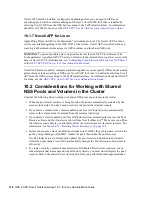
Configuring Cluster Resources for Shared NSS Pools and Volumes
137
no
vd
ocx
(e
n)
7 Ja
nua
ry 201
0
10.3 Creating NSS Shared Disk Partitions and
Pools
NSS pools can be cluster-enabled at the same time they are created or they can be cluster-enabled at
a later time after they are created. For information about managing NSS pools, see “
Managing NSS
Pools
” in the
OES 2 SP2: NSS File System Administration Guide
.
Section 10.3.1, “Initializing Shared Devices,” on page 137
Section 10.3.2, “Enabling Sharing on a Device,” on page 137
Section 10.3.3, “Creating Shared NSS Pools,” on page 138
10.3.1 Initializing Shared Devices
All uninitialized devices that you want to use in a cluster-enabled pool must be initialized by using
NSSMU or iManager before you can create cluster-enabled NSS pools on them.
Initialized devices with available free space are listed when you create an NSS pool. If a device that
you want to use does not appear in the list of available devices, it might be because it has not yet
been initialized. It might also mean that there is no free space on the device.
WARNING:
The initialization process completely removes all the partitions on the device, and all
of the data stored on the device is lost. Do not initialize devices that already contain data unless you
intend to remove all of the data on the device.
To initialize a device:
1
Start NSSMU by entering
nssmu
at the terminal console of the master node of the cluster.
2
From the NSSMU main menu, click
Devices
.
A list of devices appears in the
Devices
list.
3
In the
Devices
list, select a device (such as
sdc
).
4
Press F3,
Initialize Disk
.
5
Exit NSSMU, or continue with
Section 10.3.2, “Enabling Sharing on a Device,” on page 137
.
10.3.2 Enabling Sharing on a Device
All devices that you want to use in a cluster-enabled pool must be enabled for sharing by using
NSSMU or iManager before you can create cluster-enabled NSS pools on them.
Storage devices must be available via a shared storage area network (SAN) in order to be failed over
between servers in the cluster. NSS supports Fibre Channel SAN and iSCSI SAN environments.
External SCSI device arrays can also be configured for multiple server access.
Before enabling sharing on shared storage, Novell Cluster Services must be installed and running on
your servers.
To enable sharing for a device:
1
Start NSSMU by entering
nssmu
at the terminal console of the master node of the cluster.
2
From the NSSMU main menu, click
Devices
.
Содержание OPEN ENTERPRISE SERVER 2 SP 2 - CLUSTER SERVICES 1.8.7 FOR LINUX
Страница 4: ...4 OES 2 SP2 Novell Cluster Services 1 8 7 for Linux Administration Guide novdocx en 7 January 2010 ...
Страница 22: ...22 OES 2 SP2 Novell Cluster Services 1 8 7 for Linux Administration Guide novdocx en 7 January 2010 ...
Страница 58: ...58 OES 2 SP2 Novell Cluster Services 1 8 7 for Linux Administration Guide novdocx en 7 January 2010 ...
Страница 90: ...90 OES 2 SP2 Novell Cluster Services 1 8 7 for Linux Administration Guide novdocx en 7 January 2010 ...
Страница 132: ...132 OES 2 SP2 Novell Cluster Services 1 8 7 for Linux Administration Guide novdocx en 7 January 2010 ...
Страница 156: ...156 OES 2 SP2 Novell Cluster Services 1 8 7 for Linux Administration Guide novdocx en 7 January 2010 ...
Страница 180: ...180 OES 2 SP2 Novell Cluster Services 1 8 7 for Linux Administration Guide novdocx en 7 January 2010 ...
Страница 194: ...194 OES 2 SP2 Novell Cluster Services 1 8 7 for Linux Administration Guide novdocx en 7 January 2010 ...
Страница 212: ...212 OES 2 SP2 Novell Cluster Services 1 8 7 for Linux Administration Guide novdocx en 7 January 2010 ...
Страница 254: ...254 OES 2 SP2 Novell Cluster Services 1 8 7 for Linux Administration Guide novdocx en 7 January 2010 ...






























